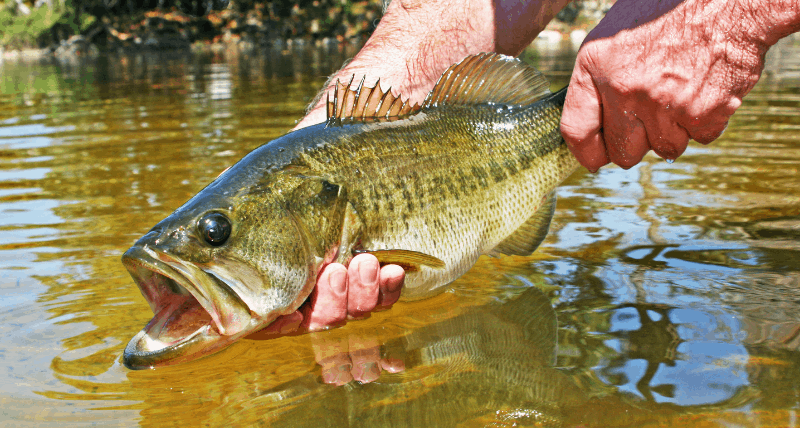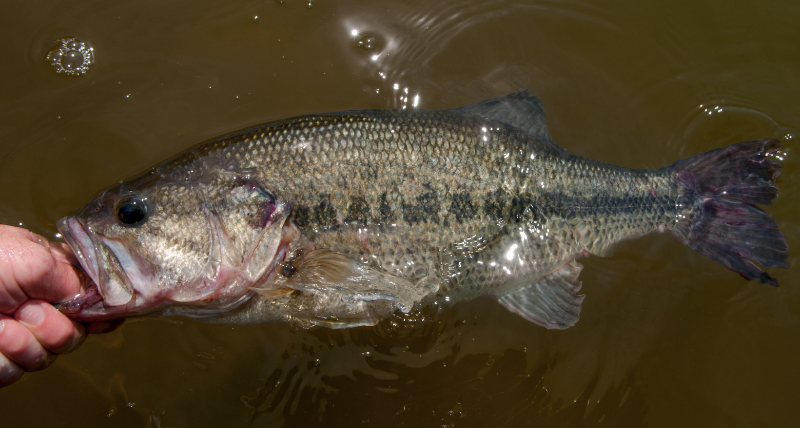Bass fishing in spring can provide some of the best bass fishing all year long, both in terms of catching large fish, as well as for catching lots of fish. It’s an ideal time to make your move on those trophy-size largemouth females that are sitting tight, waiting for warmer water temperatures before they move into the spawning areas.

Let’s take a look at 7 essential spring bass fishing tips and tactics to increase your chances of catching bass during the spring season.
Monitor water temperature to catch more spring bass
Bass behavior in spring is highly dynamic. It can be divided into 3 main phases, each with completely different bass behavior:
- Pre-spawn
- Spawn
- Post-spawn
Each of these phases requires different tactics in order to be successful, which poses a challenge to bass anglers.
During the pre-spawn phase, bass feed aggressively while they’re getting ready for spawning, and this is a great opportunity for catching lots of them. If you can find the staging areas of pre-spawn bass, you better hold on to your hat, as there’s a good chance you’ll catch your personal best, if you hook one of the large females.
The problem is that as soon as the water warms up sufficiently, the bass proceed to the actual spawning phase, and at this time they are not interested in feeding at all. During spawn it’s almost impossible to get bass to bite, even if you use reaction baits. So you might find yourself catching dozens of fish one week, only to get completely skunked the following week.
But if this happens to you, there is a very effective strategy that can help you to catch bass even at this time, based on measuring the water temperatures in different parts of your lake (this tip originally comes from Robert Ceran, founder at Sportfishing Buddy).
As you may already know, bass don’t spawn at exactly the same time all over a lake, due to the fact that the water warms up at different rates in different parts of the lake. So if the bass in one part of the lake is currently spawning, there’s a good chance that you can find others that are still in the pre-spawn phase in another part of the lake, and these fish are still feeding actively.
So if you find that the bass abruptly stop biting after a warming spell in spring, check the water temperature of that part of the lake. Then roam around with your boat and look for other parts of the lake where the water temperature is at least 3 to 4 degrees lower, and use a search bait to locate pre-spawn bass in those areas.
Fish both shallow and deep
During early spring bass tend to push into incredibly shallow water, where the water temperatures are the highest. But as temperatures continue to climb, you will start to find fish bedding out in deeper areas, especially in clear water lakes.
In many cases, you may find that the only bass you find on the shallow flats, bays, and channels early on are the small male or “buck” bass. The males typically arrive before the large females during pre-spawn, and start making spawn beds prior to the females arriving. The females will most likely arrive within a week if weather conditions remain stable and the water temperatures climb. This brings us to our next topic, depth.
Some of the best spring fishing areas are ones that are located between shallow and deep areas. These mid-depth areas between the shallow water and deep water are transition zones that bass use as staging areas, while they prepare to move into the very shallow spawning areas.
So if you’re only encountering small male bass in the shallow water but no large females, try to look for slightly deeper water in the vicinity. In some cases, you may be able to pick up some females there.
Slow down your presentation
Lure speed and size are dictated by water temperature in the spring. Lower water temperatures require a slower retrieve speed or jigging presentation, and in many cases, a downsized bait as well. If the water is really cold, try using micro jigs and other finesse baits.
But as the water temperature goes up, you can speed up your retrieve rate and bait sizes. The specifics of this can change from day to day depending on the weather and other factors, so you need to be prepared to do some experimenting, to see what works best on any given day.
Cover lots of water
During both pre-spawn and post-spawn, when the fish are off of their spawning beds, it’s important to cover large areas of water to find active fish. This can be exceptionally advantageous in the post-spawn phase, as fish spread out and start feeding actively to recover energy that was spent during the spawn.

In order to cover lots of water, it’s best to use search baits that are easy to cast far, and that works well at different depths. Great search baits for covering large areas in the spring are swim jigs – you can work them in shallow water and around thick cover, and you can pop, jig, or snap them to entice strikes. Spinnerbaits are another natural winner for covering lots of water and certainly don’t discount a swimbait during this time either.
Pay attention to water clarity
Water clarity can have a big effect on where bass can be found in the spring months. If the water is very clear, fish are likely to hold much deeper than you think. In some gin-clear lakes of Northern Wisconsin, it’s not unusual to see panfish and other species making beds in 15 feet of water.
In contrast to this, fish in stained water lakes are most likely to be in shallow water for large portions of the season, not just in spring. And if you’re fishing in a stained water lake, bass can be typically found around shallow cover that’s close to deep water during the spring months.
Targeting cover is crucial for catching bass in either clear or stained water. In stained lakes, you will find a lot of bass stacked up around tree stumps, laydowns, brush piles, and under docks. If there is any emergent vegetation around (like lily pads), these are also good areas to target in spring.
In clear lakes, you might find the bass in shallow areas, particularly areas with new weed growth, which will start later in the spring as compared to lakes that warm up quicker. Any deep or mid-depth structure like rocks, brush piles, timber, and fish cribs, may hold fish pretty quickly after they have spawned.
Match the hatch with your lure selection
Post-spawn bass are easy to find if you can locate their food sources. Areas like creek inlets, marsh areas, marinas, and shallow bays will hold large schools of baitfish like chubs, shiners, and crayfish. Once you find these areas, fish them regularly and thoroughly to pick them apart. Many of these will become your preferred spots every spring.
Try using colors and patterns that match the baitfish that are present in these spots. Matching the hatch can do wonders, but in some cases, you need to vary your presentation to help your bait stand out amongst the crowd. Popping, pausing, twitching, and other erratic actions can help trigger bass to choose your bait over the plethora of baitfish swimming around.
If those tactics don’t work, try throwing a bright and vibrant colored bait for a while. Sometimes you need to really get the bass to turn their heads.
Use sight fishing
If you want to try sight fishing for bass, it’s essential to get a high-quality pair of polarized fishing glasses. I used to be in the cheapo camp for many years, buying 20-dollar shades from the Walmart fishing section, but that was until my buddy gave me a spare pair of Costa Del Mar sunglasses for 50 bucks. I was blown away, seeing things in a lake I thought I knew like the back of my hand, that I had simply never noticed before.
Spring fishing for bass goes hand in hand with sight fishing, due to the fact that the bass are inhabiting shallow water at this time of the year. Use your glasses to search around docks, laydowns, brush piles and other shallow cover, and you will find the fish.
Get in the habit of slowly and stealthily moving through shallow areas and just look for fish, and then target them with precise casts. This approach means less speed casting to cover lots of ground, and instead making a few precision casts to specific fish. You’ll get an incredible rush of adrenaline when you see a bass lunge forward to grab your bait.
Conclusion
While fishing before, during, and after the bass spawn can be tricky at times, there are other times in the spring where the bass will bite like crazy, and you will be catching tons of them. So make sure to study the weather, figure out what stage of the spring bass cycle you are in, and fish accordingly.

